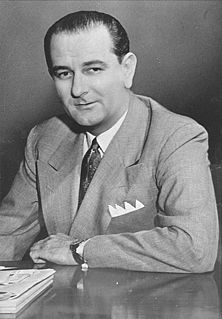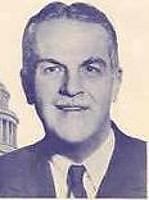The three classes of United States senators are made up of 33 or 34 Senate seats each. The purpose of the classes is to determine which Senate seats will be up for election in a given year. The three groups are staggered such that senators in only one of the classes are up for election in any two-year cycle, rather than having all 100 seats up for election at once. Thus, the 33 Senate seats of class 1 were up for election in 2018, the elections for the 33 seats of class 2 will take place in 2020, and the elections for the 34 seats of class 3 will be held in 2022.

The Hawaii Republican Party is the affiliate of the Republican Party (GOP) in Hawaii, headquartered in Honolulu. The party was initially strong during Hawaii's territorial days, but following statehood the Democratic Party took control and is currently one of the weakest Republican affiliates along with the District of Columbia Republican Party.

The 1958 United States Senate elections were elections for the United States Senate which occurred in the middle of President Dwight D. Eisenhower's second term. As is common in midterm elections, the party in the White House lost seats, but losses this year were more than usual, perhaps due to the high unemployment of the Recession of 1958. The Eisenhower Administration's position on right-to-work issues galvanized labor unions which supported Democrats. The launch of Sputnik may also have been a factor.

The 1956 United States Senate elections were elections for the United States Senate that coincided with the re-election of President Dwight D. Eisenhower. Although Democrats gained two seats in regular elections, the Republicans gained back two seats in special elections, leaving the party balance of the chamber remained unchanged.

Quentin Northrup Burdick was an American lawyer and politician. A member of the North Dakota Democratic-NPL Party, he represented North Dakota in the U.S. House of Representatives (1959–1960) and the U.S. Senate (1960–1992). At the time of his death, he was the third longest-serving senator among current members of the Senate.

Robert Winthrop Kean was an American Republican Party politician and member of one of the nation's oldest and longest serving political families. He served ten terms in the United States House of Representatives representing New Jersey.
The Republican Party of Pennsylvania, commonly known as the PA GOP, is based in Harrisburg in the United States state of Pennsylvania. It is affiliated with the Republican Party of the United States.

The 1958 California gubernatorial election took place on November 4, 1958.

The 1955 Australian federal election was held in Australia on 10 December 1955. All 122 seats in the House of Representatives and 30 of the 60 seats in the Senate were up for election. An early election was called to bring the House and Senate elections back in line; the previous election in 1954 had been House-only. The incumbent Liberal–Country coalition led by Prime Minister Robert Menzies increased its majority over the opposition Labor Party, led by H. V. Evatt.

The 1919 Australian federal election was held on 13 December 1919 to elect members to the Parliament of Australia. All 75 seats in the House of Representatives and 19 of the 36 seats in the Senate were up for election. The incumbent Nationalist Party government won re-election, with Prime Minister Billy Hughes continuing in office.

The 2008 United States elections were held on November 4. Democratic Senator Barack Obama of Illinois won the presidential election, and Democrats bolstered their majority in both houses of Congress.

The 1958 New York state election was held on November 4, 1958, to elect the Governor, the Lieutenant Governor, the State Comptroller, the Attorney General, a judge of the New York Court of Appeals and a U.S. Senator, as well as all members of the New York State Assembly and the New York State Senate.

The Union for the New Republic, was a French political party founded on 1 October 1958 that supported Prime Minister Charles de Gaulle in the 1958 elections.
This is a list of members of the Australian Senate from 1956 to 1959. Half of its members were elected at the 9 May 1953 election and had terms starting on 1 July 1953 and finishing on 30 June 1959; the other half were elected at the 10 December 1955 election and had terms starting on 1 July 1956 and finishing on 30 June 1962. The process for filling casual vacancies was complex. While senators were elected for a six-year term, people appointed to a casual vacancy only held office until the earlier of the next election for the House of Representatives or the Senate.
The United States Senate elections of 1804 and 1805 were elections that expanded the Democratic-Republican Party's overwhelming control over the United States Senate. The Federalists went into the elections with such a small share of Senate seats that even if they had won every election, they would have still remained a minority caucus.
The United States Senate elections of 1848 and 1849 were elections which had the Democratic Party lose seats but maintain control of the United States Senate.
The United States Senate elections of 1842 and 1843 were elections which had the Whigs lose seats but maintain control of the United States Senate. Although they lost three seats in the general elections, they gained two of them back by the start of the first session in special elections.

The United States Senate elections of 1788 and 1789 were the first elections for the United States Senate, which coincided with the election of President George Washington. As of this election, formal organized political parties had yet to form in the United States, but two political factions were present: The coalition of senators who supported George Washington's administration were known as "Pro-Administration", and the senators against him as "Anti-Administration".

The 2014 United States elections were held on Tuesday, November 4, 2014, in the middle of Democratic President Barack Obama's second term. Republicans retained control of the House of Representatives and won control of the Senate.

The 172nd New York State Legislature, consisting of the New York State Senate and the New York State Assembly, met from January 7, 1959, to April 1, 1960, during the first and second years of Nelson Rockefeller's governorship, in Albany.












